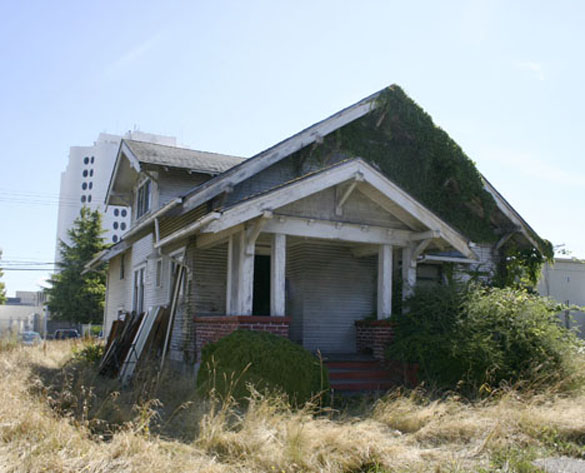It’s safe to say the 92-year-old Craftsman bungalow near the corner of South 17th Street and Martin Luther King Jr. Way has seen better days.
Steps that lead up to the front door are broken and worn.
Chipped and broken bricks contain a small front porch.
And an overgrown yard appears to be swallowing the building whole.
That said, when local historic preservationist Morgan Alexander learned recently the former home, located in the city’s Hilltop neighborhood, would be razed, he thought of ways to save the crumbling bungalow.
“The first thing that came to my mind was relocation,” said Alexander. “Unfortunately, the house is in pretty sad shape. It would need a lot of work put into it. The wiring and plumbing needed to be upgraded. A relocation would have to happen very fast — move a house, find a buyer, coordinate a site.”
Instead, Alexander — a preservationist who once served on the board of directors of Historic Tacoma — thought of another plan.
Last week he led an effort to connect the property owner with a local recycling company in order to salvage some of the building materials. On Aug. 13, workers from the Metropolitan Development Council’s ReHarvest Center were busy removing materials.
“We got a lot,” said Philip Riley of the ReHarvest Center. “We must have gotten at least six or seven doors, several built-in cabinets. We loaded a whole 16-foot flatbed.”
Today, the salvaged material is available for purchase at the ReHarvest Center, located at 1113 St. Paul Ave., instead of sitting in the city’s landfill.
The effort was part of a larger goal to revamp the City of Tacoma’s demolition and deconstruction policies. Demolition means sending the entire building to the landfill. Deconstruction means salvaging and recycling as many building materials before demolition.
Preservationists such as Alexander would like to see more of the latter.
“The thing with deconstruction is that the cost is actually about the same as tearing it down and throwing it in the landfill,” says Alexander. “But there are not really any incentives or rewards for deconstruction. Right now, it’s kind of a backward policy at the City that has unintended side effects. The challenge is going to be to come up with a way to create incentives to encourage more deconstruction as opposed to demolition and trucking to landfills.
Alexander adds: “We’re hoping that with an improved demolition process in the city, it can help encourage things like moving the house instead of demolition or deconstruction. The priority should be move the house if you can. If not, deconstruct it. There’s all sorts of opportunity for keeping stuff out of the landfill.”
According to Historic Tacoma, the combination of increasing wood prices and a greater awareness of recycling opportunities makes it practical to salvage old growth timber featured in many older homes. Recently, the organization made presentations to City Council committees arguing for policy revisions that incorporate adaptive re-use of building materials in older structures slated for demolition.
Are there any requirements today for developers to recycle or salvage materials from old buildings slated for demolition?
“Not that I’m aware of,” says Michelle Warmuth, spokesperson for the City’s Solid Waste Management Division. However, Warmuth says the department does assist people who want to recycle construction demolition material by providing a list of private recycling companies.
For Emery Chang, owner of the Craftsman bungalow, letting salvagers onto his property last week to remove building materials was an easy decision.
“There’s no benefit to me, and no cost to me,” says Chang, who owns a number of historic properties in the Hilltop neighborhood, including the First Swedish Baptist Church at 1201 S. J St. In 2006, he received an award for outstanding achievement in historic preservation from the City’s landmarks preservation commission. “Unfortunately, this place sits in the way of development. It will go down.”
Indeed, the Craftsman and two other buildings on the property will be razed. Chang said he plans to trade the parcel for an adjacent piece of land owned by St. Joseph Medical Center; the hospital plans to operate the property as a parking lot. “A marginal benefit is that the stuff [ReHarvest] takes is just a little bit less that goes to the landfill,” says Chang.
Still, he agrees with Alexander that the larger issue is a lack of incentives for developers to salvage or recycle building materials. “The reality is there just continues to be no incentive [to salvage building materials],” adds Chang. “It’s easier to knock buildings down. Right now, the economic incentive is to destroy and landfill.”


Todd Matthews is editor of the Tacoma Daily Index and recipient of an award for Outstanding Achievement in Media from the Washington State Department of Archaeology and Historic Preservation for his work covering historic preservation in Tacoma and Pierce County. He has earned four awards from the Society of Professional Journalists, including third-place honors for his feature article about the University of Washington’s Innocence Project; first-place honors for his feature article about Seattle’s bike messengers; third-place honors for his feature interview with Prison Legal News founder Paul Wright; and second-place honors for his feature article about whistle-blowers in Washington State. His work has also appeared in All About Jazz, City Arts Tacoma, Earshot Jazz, Homeland Security Today, Jazz Steps, Journal of the San Juans, Lynnwood-Mountlake Terrace Enterprise, Prison Legal News, Rain Taxi, Real Change, Seattle Business Monthly, Seattle magazine, Tablet, Washington CEO, Washington Law & Politics, and Washington Free Press. He is a graduate of the University of Washington and holds a bachelor’s degree in communications. His journalism is collected online at wahmee.com.








